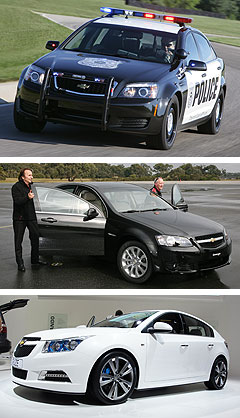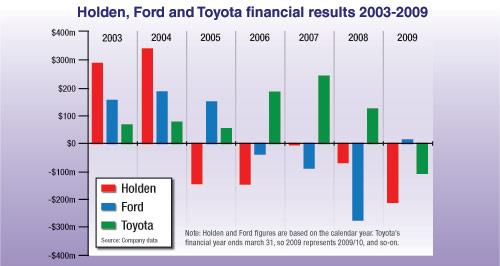News - HoldenHolden ‘turns corner’ on balance sheetCruze to profitability: The Cruze will become the first Australian-built small car since the demise of the local Toyota Corolla more than a decade ago. Holden chief charts profitability course, despite tough local market, export squeeze9 Dec 2010 By TERRY MARTIN GM HOLDEN chairman and managing director Mike Devereux revealed this week that the company remained on track to return to profitability in 2010 for the first time in six years. The result would end a string of losses for Holden, having slipped into the red in 2005 with a $144.6 million loss – which came off a $335.5m profit in 2004 and was attributed to development costs for the $1 billion-plus VE Commodore – and subsequently recording net losses of $146.6m in 2006, $6.1m in 2007, $70.2m in 2008 and, in 2009, $210.6m. The latter was the worst result in the company’s history and blamed on a combination of factors, primarily the global financial crisis and the demise of the Pontiac export program to the US. However, upon announcing that result late in March this year, Holden said it had been operating profitably during 2010 and that its outlook would continue to improve in line with the strengthening Australian new-car market and as export opportunities turned into firm programs.  From top: Chevrolet Caprice PPV, Chevrolet Omega Fittipaldi, Chevrolet Cruze hatch. From top: Chevrolet Caprice PPV, Chevrolet Omega Fittipaldi, Chevrolet Cruze hatch.That has transpired on both counts, with Holden’s sales up 13.6 per cent over 11 months of trading this year and with new export orders now rolling in from the US for the new Statesman-based Chevrolet police patrol car – a lucrative program that should boost annual production by tens of thousands of units at its plant in Elizabeth, South Australia. The company also recently commenced a smaller-scale VE Series II Commodore-based export program to Brazil. In a speech to the American Chamber of Commerce this week, Mr Devereux stopped short of confirming that Holden had turned a profit in all three quarters this year – saying only that General Motors had achieved such a feat – but nonetheless said he should be announcing a profit for 2010 when the figures are released around March next year. “In terms of a financial turnaround, GM has regained its cost competitiveness and turned a profit for three consecutive quarters this year,” he said. “Having a profitable foundation is critical for every part of business – whether it’s Holden in Australia, Chevrolet in India, Opel in Europe or Buick in China. “China has actually become the real powerhouse in the GM world. A couple of weeks ago, it became the first international car company to sell two million cars in China, which, by the way, is more cars than GM sells in the US. “Holden, which for many years was the driving force in GM’s Asia Pacific region, has also turned the corner. I look forward to reporting a profit for the first time in six years when we release our 2010 annual results.” Mr Devereux said the company still “faces challenges”, which include the current high valuation of the Australian dollar, which is almost at parity with the US dollar. This situation limits export growth and, on the flipside, has enabled importers to become more cost-competitive against the locals here on the home front. GoAuto understands that the US police car program, for example, was based on an exchange rate of around 80 US cents. “Having a nine on the front (of the exchange rate) certainly squeezes our business in the short-term, but we never approach export programs like day traders,” Mr Devereux said. “We develop these programs for the long haul and the tight exchange situation only further reinforces our need to have a profitable domestic business model. “Does it stop us pursuing other export opportunities? Absolutely not.” Holden’s return to small-car production with the Cruze is also sure to be among the challenges the company faces. As GoAuto has reported, the Cruze will become the first Australian-built small car since the demise of the local Toyota Corolla more than a decade ago, and will be Holden’s first Australian-built four-cylinder car since it ended Vectra production in 2000. Whether positive or negative, Cruze will have a major influence on Holden’s bottom line in the coming years, and Holden will have its work cut out to ensure it does not follow other local small cars – from a range of manufacturers – in succumbing to the ultra-competitive Asian imports. Whereas Cruze will be built in South Korea, China, the US and other countries – a fact that has drastically curtailed Australian export prospects – imported small cars sold here are, as we have noted before, increasingly sourced from low-cost countries with massive volumes and, hence, sharp economies of scale. “We still face challenges, absolutely, but Holden is a leaner, more robust, flexible and competitive car company today than at any time in our history,” Mr Devereux said this week. “Most people probably know Holden best as a global niche exporter. While we still have a competitive advantage in this area, we have been forced to address two important things: improving our structural cost and the profitability of our domestic business. “Traditionally we’d relied very heavily on exports to make money, but the GFC and the cancellation of the Pontiac brand in the United States and Canada took around 50,000 G8 export vehicles out of the plant, literally overnight. “It brought home, extremely quickly, the need to restructure our business in order to make money at the bottom of the cycle – and on our domestic business alone. “It was also clear that to do this we needed even greater flexibility – which meant being better able to meet the demands of the local market beyond large cars.” Mr Devereux acknowledged the hundreds of millions in company and government money that has been pumped into the Cruze program, adding: “What is really incredible about this story is that at the depths of the worst crisis this industry had seen, perhaps in history, this country and this company, Holden, made a huge statement about the future of manufacturing hi-tech products in Australia. “We know the demand is there. Now with local Cruze we can give Australians a locally produced, global small car which has been re-engineered for Australian conditions. “The ability to locally manufacture small and large cars gives us the flexibility to adjust our production between the two vehicle families depending on the needs of the market. It ensures a more stable workload for our employees and has created new business opportunities for our local suppliers. “It is such a great feeling to see the ‘open’ sign on the recruitment office door again such a small thing, but such an important symbol of recovery.” Significantly, Ford Australia announced this year that it had unexpectedly returned to profitability in 2009 – without reverting to small-car production, which had been the basis upon which it would climb out from the red (in 2011). New Ford Australia president Robert Graziano is now tasked with improving Ford’s position beyond the $13 million profit posted last year, following former chief Marin Burela’s promise of further gains in profitability in the years ahead. Last year’s profit for Ford was its first positive result since 2005 (when it posted a $148.2m profit, down from $154.6m in 2003 and $185.6m in 2004) and came after a $274.4 million operating loss in 2008 – the deepest in its history – and losses of $87.2m and $40.3m in 2007 and 2006 respectively. Ford attributed last year’s $287 million turnaround to its ability to maintain healthy sales revenue ($3.14 billion, compared with $3.9b in 2008) with fewer vehicle sales – down almost eight per cent last year. This year, Ford’s sales to the end of November have increased only 0.8 per cent – well below Holden’s 13.6 per cent rise and Toyota’s 7.4 per cent climb, against a total industry improvement of 11.8 per cent. It remains to be seen whether Ford’s sales revenue has remained as strong as last year. In light of Holden’s local Cruze program, it is significant that Ford was not anticipating a return to profitability until at least 2011 under its previous strategy of building the Focus small car at its production plant in Broadmeadows. That plan was scrapped last year, with Ford deciding instead to upgrade its current Australian-built models in 2011. As we have reported, Falcon will gain a four-cylinder engine and a new-generation liquid-injection dedicated-LPG inline-six, while the Territory will pick up a turbo-diesel engine. After a consistent run of profits in Australia, even during tough economic conditions, Toyota this year recorded a $107.9 loss for its 2009/10 financial year ending March 31, 2010. The company did record a profit before tax of $182.3 million, but the net loss reflected a huge $290.2m tax bill that comprised an “under-provision” $246.7m payment, including an unspecified one-off tax settlement with the Australian Tax Office for previous years. This was the first red ink Toyota Australia had seen since the $2.7 million loss it posted in 2001/02 (which was a 15-month reporting period, from January 1, 2001, to March 31, 2002). The following year (April 1, 2002, to March 31, 2003) saw Toyota post a $10.9m profit, which was backed up by profits of $67.5m and $76.6 million in 2003/04 and 2004/05 respectively. The company’s profit fell to $54.9m in 2005/06 but strengthened in 2006/07 and 2007/08 with results of $184.4m and $242.2m respectively. It dropped back to $123.4m in 2008/09. Toyota Australia has also been hurt by declining exports, and while it remains the clear market leader in Australia, sales of its locally manufactured vehicles – Camry and Aurion – are up just 3.4 per cent this year. Ford is also hurting in sales across its entire range of locally built cars – down 3.8 per cent year to date – while Holden is in the best position of the three, up 3.4 per cent YTD but, it has to be said, by no means comfortable.  Read more |
Click to shareHolden articlesResearch Holden Motor industry news |

















Facebook Twitter Instagram